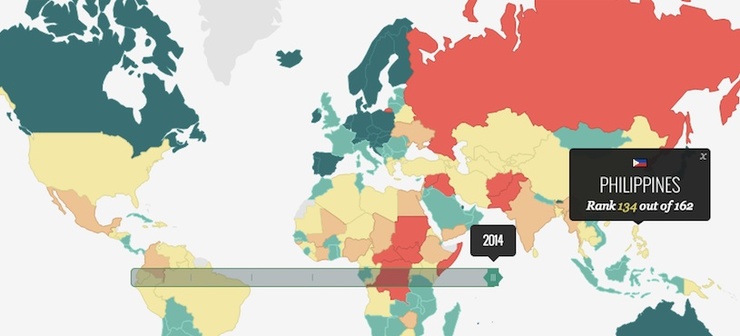Internal and external threats to peace continue to hound the Philippines, affecting its overall ranking in the 2014 Global Peace Index

PEACE TRENDS. The Philippines
As the world became less peaceful for 7 years in a row in 2013, the
The Philippines
This is due the
presence of both internal and external challenges to peace.
The Philippines is one of the countries found to
have “notable increases in terrorist activity” in 2013, along with countries
such as Afghanistan , Iraq and Libya
Another factor
that contributed to this result is the country's ongoing territorial dispute with
China over the West Philippine Sea (South China
Sea ).
In 2013, the
Philippines is also one of the countries with the largest discrepancy between
levels of peace and democracy as the country continued to rank low in the peace
index even as it exhibits “strong democratic credentials.”
The Aquino
government signed a final peace accord in
March with the Moro Islamic Liberation Front (MILF) – the biggest organized
armed group in the Philippines Southern
Philippines with a better political and fiscal structure than the
Autonomous Region in Muslim Mindanao, which it will replace.
Even as the
government and the MILF work towards implementing the peace accord, other armed
groups, reportedly with terrorist connections, continue to exist. (READ: Philippine militants pledge allegiance to ISIS
jihadists and Senior Abu Sayyaf leader swears oath to ISIS)
More than dealing
with arms and law enforcement, the report said societal and political issues –
such as widespread graft and corruption in government and the “patron-client
nature” of political institutions must also be addressed.
The report lauded
the abolition of the pork barrel system in 2013 as an “important step” towards
the responsible use of personal funds and making politics “less personalized”
but noted that is still “insufficient.”
Meanwhile, the
report said the case filed by the Philippines
against China before UNCLOS
to claim parts of the West Philippines Sea
(South China Sea ) as “risky” as it could
“result in a long-term estrangement between the two sides.”
Global
trend
Across the world,
the index found that global peace has deteriorated since 2008, with conflict in
Eastern Ukraine, the Gaza strip and Libya
How much did
conflict and violence all over the world cost? A total of $9.8 trillion in
damages, corresponding to 11.3% of global gross domestic product (GDP), the
report said. This is equal to twice the total GDP of entire Africa .
The index ranks
the peace situation in each country not just by the lack of conflict, whether
external or internal, but also by looking at how the country maintains and
prevents conflict.
Among the factors
considered are:
Well-functioning
government
Sound business
environment
Equitable
distribution of resources
Acceptance of the rights of others
Good relations with neighbours
Free flow of information
High level of human capital
Low levels of corruption.
Acceptance of the rights of others
Good relations with neighbours
Free flow of information
High level of human capital
Low levels of corruption.
http://www.rappler.com/nation/special-coverage/peacetalks/67063-philippines-2014-global-peace-index

No comments:
Post a Comment
Note: Only a member of this blog may post a comment.